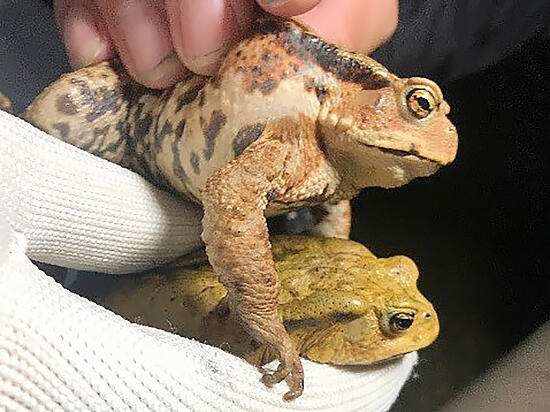
The research group of Professor Hitoshi Araki and colleagues of the Research Faculty of Agriculture at Hokkaido University announced that they had developed a method to detect the reproductive area of domestic non-native Bufo japonicus formosus, which has been a problem for native species, by analyzing environmental DNA. The method can be used to easily estimate the reproductive area of Bufo japonicus formosus, based on a wide range, by detecting its DNA in water collected from reproductive ponds and downstream rivers during the reproductive season. An analysis of the entire Ishikari River detected the DNA of this species in 32 of 73 sites, showing that its reproductive area extends widely across the river system. This discovery is expected to contribute to the maintenance and management of the ecosystem. The group's findings were published in the December 15th issue of the international scientific journal Biological Invasions.
Although Bufo japonicus formosus is native to eastern Japan, it did not originally inhabit Hokkaido, and this domestic non-native species was first discovered in Hakodate in 1912. It was then discovered in Asahikawa in 1995 and Sapporo in 2007, and there have been concerns that its distribution is expanding. In 2015, Bufo japonicus formosus was designated as a non-native species based on the ordinance on the conservation of biodiversity in Hokkaido.
This toad species has a strong neurotoxin (bufotoxin), which is even present in its larva. Thus, mass death of some amphibians with no immunity to Bufo japonicus formosus, such as Hokkaido-native Rana pirica, has been reported as a result of sharing reproductive ponds and preying on larva (tadpoles). Local residents in the vicinity of the Ishikari River, that connects Asahikawa and Sapporo, have played a central role in the extermination of Bufo japonicus formosus. However, the toad species is nocturnal, and its adults are terrestrial, making extermination difficult. Therefore, the expansion of its distribution has not been controlled.
The research group has developed a study on environmental DNA technology that can detect DNA contained in water, such as rivers and lakes, and identify surrounding organisms. They performed a time-series analysis of environmental DNA from a river with a reproductive pond of Bufo japonicus formosus upstream, which showed that early- to mid-June, when many of the larvae are still in the pond, is the optimal period to detect environmental DNA.
Then, the research group aimed to develop a technology to quickly and easily identify the reproductive rivers of Bufo japonicus formosus among a large number of branch rivers flowing into the Ishikari River.
First, they established the Bufo-specific DNA sequence method for the first time in the world. In 2018 and 2019, to examine the accuracy of this method, they sampled water in eight habitats, where the presence of Bufo japonicus formosus larvae was confirmed, in June before the larvae became adults. Then, they extracted environmental DNA and estimated the amount of toad DNA by quantitative PCR analysis. Although this method cannot distinguish Bufo japonicus formosus from the original subspecies Bufo japonicus, it is known that there are no Bufonidae species native to Hokkaido.
As a result, the method detected DNA from Bufo japonicus formosus in all eight habitat ponds, validating its accuracy.
Subsequently, they sampled water at 73 sites in 31 rivers of the Ishikari River system, mainly in Asahikawa River, and analyzed the samples in the same manner. From this, they detected DNA from Bufo japonicus formosus at 32 of the 73 sites (43.8%). Of these, 21 sites had no information of previous sightings of this toad species within a radius of 500 m. This study showed that DNA from the toad species could be detected in 12 rivers, including the main river of Ishikari River, and that it might be widely breeding within the Ishikari River water system.
Adult Bufo japonicus formosus is terrestrial, and it was difficult to observe its existence. However, this technology allows for the confirmation of not only its existence but also its reproduction. In addition, its DNA could not be detected in areas distant from the reproductive ponds, even downstream.
Professor Araki commented, "We expect that understanding the reproduction before the expansion of distribution will lead to effective control. Since the only on-site work of this method is water sampling and filtration, we would like the local community to use it to monitor the ecosystems."
This article has been translated by JST with permission from The Science News Ltd.(https://sci-news.co.jp/). Unauthorized reproduction of the article and photographs is prohibited.




